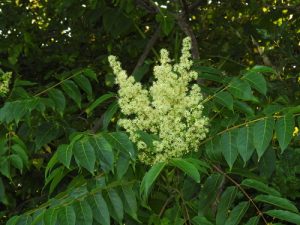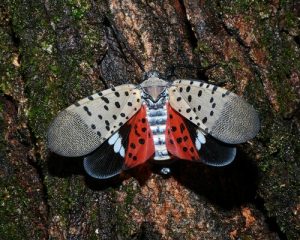By Laura Warman, Grants Manager
Like many others, the first time I ever heard of Tree of Heaven was in the pages of A Tree Grows in Brooklyn by Betty Smith. I remember being entranced by the description of “…a tree that grows in Brooklyn. Some people call it the Tree of Heaven. No matter where its seed falls, it makes a tree that struggles to reach the sky. It grows in boarded-up lots and out of neglected rubbish heaps. It is the only tree that grows out of cement. It grows lushly […] survives without sun, water, and seemingly without earth. It would be considered beautiful except for too many of it.” Little did I know then that later in life, I would come to know this tree very well (I can see one out my window as I type), that they can grow just about everywhere, or that I would come to understand that last part of the description very clearly and personally.
Tree of Heaven (Ailanthus altissima) is native to temperate parts of China, where it is considered medicinal and is grown as food for moths that can produce a type of silk (but not the silkworms that most silk comes from). It was brought to the United States as an ornamental shade tree in 1784, and it didn’t take too long to start to be seen as a widespread weed (as nicely described by Betty Smith in 1943). While its weediness made it fall out of favor with landscapers, Tree of Heaven had no trouble spreading out on its own and establishing itself prolifically in new lands. This fast-growing tree is now recognized as an invasive weed across the U.S. and as one of the essential invasive trees in the forests of the East Coast. Tree of Heaven crowds out native species from their natural habitats, damages human buildings and other structures (it does love growing out of small cracks in cement!), and poses a nuisance and threat to agriculture.
Tree of Heaven trunks can grow to over 80 feet tall and reach more than 6 feet in diameter. Still, they are commonly found in North Carolina as somewhat slender trees with a smooth grey trunk, often growing in dense clusters and thickets- especially on roadsides. Their leaves are often confused with native black walnut (Juglans nigra) or sumac (Rhus spp.), and their bundles of seeds look like those of ash trees (Fraxinus spp.). There are many online resources to aid in identifying Tree of Heaven, but one tell-tale sign is that their leaves and stems have a distinct smell when crushed– it always makes me think of a cross between rancid peanut butter and burnt rubber.
One of the many reasons they have spread like wildfire across the U.S. is that in addition to seeding prolifically, Tree of Heaven grows enthusiastically from suckers. They put out extensive lateral root systems that can easily reach over 50 feet away from the main trunk, and when the main trunk is damaged or cut, hundreds of suckers can emerge from these roots. Because of this, it’s widely advised to treat the trees with herbicides in late summer and fall before cutting them down. I learned the hard way that while seedlings are easy to pull up, the suckers are firmly anchored to the underground root network. As if all of this wasn’t enough- there’s also evidence that the Tree of Heaven secretes substances into the soil that inhibit other plants (like red oaks, Quercus rubra) from growing nearby, so their presence can change forest composition.
Trees of Heaven are problematic enough on their own, but now they appear to be a gateway for a new invasive threat- the spotted lanternfly (Lycorma delicatula). This Asian insect is not a fly but a planthopper, a cousin of cicadas that uses a long beak to pierce plant tissues and suck up fruit sap and juices. Trees of Heaven are the lanternflies’ preferred host plant. Still, lanternflies aren’t very picky and feed on over a hundred species, including natives like grapes, Virginia creeper, maple, birch, and walnut- they are considered an essential threat to crops and ornamental species. Spotted lanternflies have spread since being found in Pennsylvania in 2014, and a population was confirmed in North Carolina in June of this year. If you find one, please report it to the N.C. Department of Agriculture!
TLC stewardship staff and volunteers work hard to keep Tree of Heaven and other invasive species out of our preserves. This year we’re incredibly excited about a grant from the Cornell Lab of Ornithology that supports our efforts to keep invasive species out of Brumley Nature Preserve and helps us improve bird habitat. You can also help! Sign up for one of our volunteering crews, join an event, and ensure your yard is free of invasive species.


